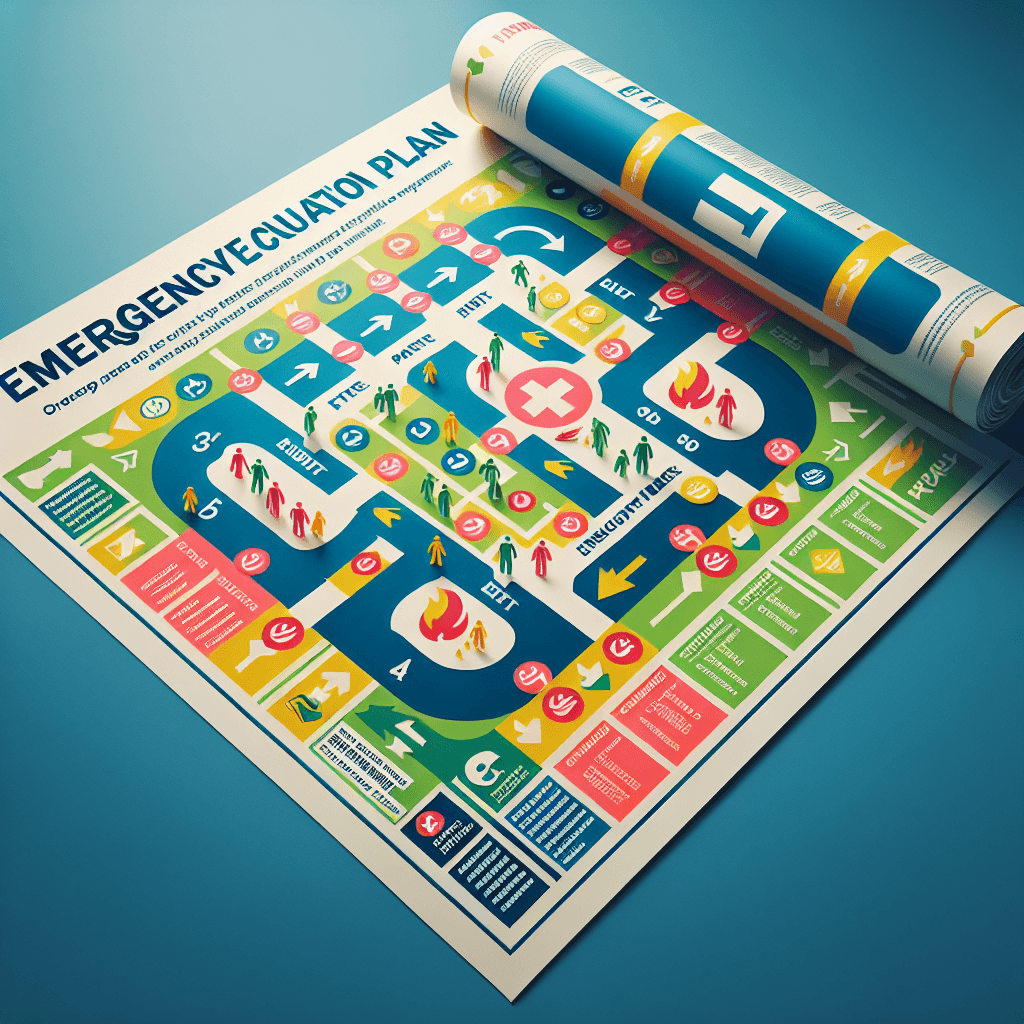In the event of an emergency, the ability to efficiently and effectively evacuate can mean the difference between life and death. This comprehensive article provides a concise and practical guide for navigating emergency evacuations step by step. From developing an emergency plan to executing a swift and safe evacuation, you will gain invaluable insights to ensure the well-being and safety of yourself and others in any emergency situation.
Table of Contents
Emergency Evacuation: A Step-by-Step Guide

Preparing for Emergency Evacuation
Evaluate the Risks
Before an emergency occurs, it is crucial to evaluate the risks specific to your geographical location. Assess potential hazards such as floods, hurricanes, wildfires, earthquakes, or industrial accidents. Research the history of emergencies in your area to better understand the potential risks and their severity.
Develop an Emergency Plan
A well-thought-out emergency plan is vital for a successful evacuation. Start by identifying a safe location where you and your family will gather in case of an emergency. This could be a relative’s house or a designated community shelter. Develop a step-by-step plan detailing the actions to take during an evacuation, including how to reach the safe location and who to contact. Ensure that every family member is familiar with the plan and knows their roles and responsibilities.
Create a Communication System
During an emergency evacuation, effective communication is essential. Establish a communication system that everyone in your household can rely on. This could include identifying a designated family member as the main point of contact, exchanging emergency contact information with neighbors, and utilizing various communication tools such as phones, walkie-talkies, or social media platforms. Having a reliable communication system in place will help ensure that everyone stays informed and connected.
Designate Safe Meeting Points
In the chaos of an emergency evacuation, it is easy to get separated from your loved ones. Therefore, it is crucial to designate safe meeting points both within your immediate vicinity and outside of your neighborhood. Choose easily identifiable locations like a nearby park or a specific store where your family can regroup if you become separated during the evacuation. Make sure that everyone in your household is familiar with these meeting points and understands the importance of gathering there in case of separation.
Emergency Supplies
Water and Food
When preparing for an emergency evacuation, it is essential to have an ample supply of water and non-perishable food. Aim for at least one gallon of water per person per day, and ensure that you have enough food to sustain your family for a minimum of three days. Choose nutrient-dense and easy-to-store items like canned goods, energy bars, and dried fruits. Don’t forget to pack a manual can opener and any necessary utensils.
First Aid Kit
A well-stocked first aid kit is a vital component of your emergency supplies. Include essentials such as bandages, sterile gauze, adhesive tape, disinfectant, pain relievers, antiseptic wipes, and any prescription medications specific to your family’s needs. Familiarize yourself with the contents of the kit and ensure that it is readily accessible during an evacuation.
Prescription Medications
For individuals who rely on prescription medications, it is crucial to have an adequate supply on hand during an emergency evacuation. Keep a two-week supply of essential medications stored in a waterproof container. Regularly check and rotate medications to ensure they are not expired. Additionally, keep a copy of prescriptions and emergency contact information for healthcare providers.
Essential Documents
Gathering and protecting essential documents is a critical step in emergency preparedness. Important documents may include identification cards, passports, birth certificates, insurance policies, financial records, and any other legal documents. Store these documents in a waterproof and fireproof container or consider keeping digital copies secured on a portable storage device or in the cloud.
Creating an Evacuation Kit
Backpack or Bag
To ensure that you can quickly gather and carry your emergency supplies, have a sturdy backpack or bag designated specifically for evacuation purposes. Choose a size that is convenient to carry, yet spacious enough to fit all necessary items. Opt for a backpack with multiple compartments to keep items organized and easily accessible.
Flashlight and Batteries
a reliable flashlight and extra batteries should be part of your evacuation kit. In the event of an emergency evacuation, power outages are not uncommon, and having a flashlight will provide essential illumination. Choose a flashlight with long battery life and consider including extra batteries to ensure long-term functionality.
Whistle and Signal Devices
In situations where visibility or communication is limited, a whistle and other signal devices can be vital for attracting attention and getting help. Include a waterproof whistle in your evacuation kit, which can be used to alert rescuers to your presence. Additionally, consider including a signal mirror, glow sticks, or a brightly colored cloth for increased visibility.
Cash and Spare Keys
In the midst of an emergency evacuation, access to cash and spare keys can prove invaluable. Keep a small amount of cash, preferably in smaller denominations, as well as spare keys to your home, car, and any other important locks. Place these items in a waterproof and easily accessible pouch within your evacuation kit.
Notifying Authorities
Call Emergency Services
In the event of an emergency, the safety of individuals and property should be the top priority. If immediate assistance is required, call emergency services such as 911 to report the emergency and seek help. Be prepared to provide accurate information about your location, the nature of the emergency, and any potentially life-threatening situations.
Contact Local Authorities
In certain emergency situations, it may be necessary to contact local authorities to report hazards or receive updates. Research and save the contact information for your local police department, fire department, and other relevant agencies in your area. Be prepared to provide pertinent details and follow any instructions or recommendations they provide.
Inform Neighbors
A strong sense of community is crucial during times of emergency. Informing your neighbors about a pending or ongoing evacuation can ensure that everyone is aware of the situation and has the opportunity to take appropriate action. Share information about evacuation routes, nearby shelters, and any other relevant details that will help your neighbors navigate the situation safely.
Notify Workplace or School
If an emergency evacuation occurs during work or school hours, it is essential to notify your place of employment or educational institution. Inform them of the situation and follow their instructions regarding evacuation procedures or alternative arrangements. Establish a communication plan with your workplace or school to stay informed about any updates or changes.

Evacuation Routes
Identify Primary and Secondary Routes
Knowing multiple evacuation routes is crucial in case primary routes become inaccessible or congested during an emergency. Identify and familiarize yourself with both primary and secondary evacuation routes to ensure you have alternative options. Consider road closures, traffic patterns, and any local evacuation plans when determining the best routes to use.
Familiarize Yourself with Exits
Whether you are evacuating from a home, workplace, or public space, it is necessary to familiarize yourself with the exits. Take note of where the emergency exits are located and ensure that they are clear and unobstructed. In larger buildings, familiarize yourself with evacuation maps and signage indicating the quickest and safest escape routes.
Account for Children and Pets
When planning for an emergency evacuation, it is crucial to consider the needs of children and pets. Ensure that each child has a designated caregiver responsible for their safety and evacuation. Develop a plan for evacuating pets, including having carriers or leashes readily available. Make sure to include supplies such as food, water, and comfort items to keep children and pets calm during the evacuation.
Consider Transportation Challenges
During an emergency evacuation, transportation challenges can arise, especially if public transportation systems are affected. Be prepared to adapt and overcome these challenges by having alternative means of transportation available. Have a backup plan to reach your designated safe location if certain modes of transportation become unavailable or congested.
Evacuation Procedures
Stay Calm and Alert
During an emergency evacuation, it is crucial to stay calm and maintain a clear mindset. Panic can hinder decision-making and lead to unnecessary risks. Listen carefully to instructions from authorities and follow their guidance. Keeping a level head will help ensure your safety and that of others around you.
Follow Authorities’ Instructions
Local authorities are trained to handle emergencies and are experienced in directing evacuations. It is important to follow their instructions and adhere to any orders or recommendations issued through official channels. Authorities will provide vital information about evacuation routes, safe locations, and any potential hazards along the way.
Close and Lock Doors and Windows
As you evacuate, take the necessary steps to secure your home or workplace. Prior to leaving, close and lock all doors and windows to prevent unauthorized entry and reduce potential damage from environmental factors or looting. Secure valuables and important documents in a safe place or take them with you if possible.
Turn Off Utilities
Before leaving your home or workplace during an emergency evacuation, it is essential to turn off utilities to prevent further risks. Shut off gas, electricity, and water sources to minimize hazards such as fires or flooding. Familiarize yourself with the locations of utility shut-off valves in advance to expedite the process during a high-pressure situation.

Managing Communication during Evacuation
Designate a Communication Coordinator
In a large-scale emergency evacuation, it can be challenging to keep everyone informed and connected. Designate an individual within your household or group as the communication coordinator. This person will be responsible for disseminating information, ensuring that everyone is accounted for, and coordinating communication with external parties such as emergency services or family members not present in the immediate vicinity.
Use Multiple Channels to Stay Informed
During an emergency evacuation, it is crucial to stay informed about changing circumstances, official updates, and potential hazards. Utilize multiple communication channels to receive information, including local emergency alerts, radio or television broadcasts, social media platforms, and official websites. Do not solely rely on a single source of information to ensure accurate and timely updates.
Share Evacuation Status with Family
When evacuating, it is essential to keep your family members or loved ones informed about your evacuation status. Regularly provide updates on your location, safety, and any changes to your evacuation plan. Share your contact information and encourage family members to communicate with you as well. Open lines of communication will help ease anxiety and ensure that everyone is accounted for.
Connect with Local Emergency Services
During an emergency evacuation, it may be necessary to seek assistance or provide updates to local emergency services. Save the contact information for local emergency hotline numbers and familiarize yourself with alternative methods of communication if phone lines are congested or inaccessible. Reach out to emergency services if you require immediate assistance or have relevant information regarding the evacuation.
Evacuation Checklist
Secure Valuables and Important Items
Before evacuating, take the time to secure your valuables and important items. This includes collecting necessary documents, jewelry, family heirlooms, and sentimental items. Place these items in a secure, waterproof container or take them with you during the evacuation. Remember that safety should always be the priority, so only retrieve items if it is safe to do so.
Dress Appropriately for Weather
When evacuating, dress appropriately for the weather conditions. Consider the current and potential weather patterns in your area. Wear comfortable clothing and sturdy shoes suitable for walking long distances, if necessary. Layer your clothing, as it may be necessary to adapt to changing temperatures during the evacuation process.
Bring Essential Supplies
Ensure that you pack essential supplies in your evacuation kit. This includes water, non-perishable food, first aid kits, flashlights, batteries, a whistle, cash, spare keys, and any necessary medications. Consider the needs of your household members, including infants, elderly individuals, or individuals with special medical conditions, and include any additional supplies they may require.
Consider Special Needs
When preparing for an emergency evacuation, it is crucial to consider the unique needs of individuals with disabilities or other special needs. Take into account their mobility, communication, and medical requirements. Make arrangements to ensure that necessary equipment, medications, or caregivers are readily available during the evacuation process. Plan for accessible transportation and accessible accommodations at your designated safe location.

During the Evacuation
Keep Identification and Medical Information Handy
During an emergency evacuation, it is essential to keep your identification documents and medical information within reach. This includes identification cards, passports, and medical insurance cards. Having this information readily available will expedite any necessary processes, such as registration at shelters or medical facilities.
Stay in Designated Safe Areas
When evacuating, be mindful of designated safe areas along your evacuation route. These safe areas may include community shelters, designated meeting points, or areas specifically designated by local authorities. Follow instructions regarding where to gather and how to access these safe areas, as they offer protection and support during an emergency.
Follow Traffic and Evacuation Signs
During an emergency evacuation, it is vital to follow traffic and evacuation signs as they guide you to safety. Pay attention to directional signs, road closures, and detour instructions. Follow the instructed routes to avoid congested areas or potential hazards. Cooperate with traffic control personnel and emergency response teams to ensure a smooth evacuation process.
Help Others when Possible
During an emergency evacuation, remember to lend a helping hand to those in need, if it is safe to do so. Offer assistance to individuals who may require special accommodations, such as the elderly, disabled, or families with young children. However, prioritize your safety and the safety of your immediate family members first.
After the Evacuation
Account for All Family Members
Once you have reached your designated safe location, take the time to account for all family members. Verify that everyone has safely arrived and is present. Make note of any missing individuals and report their absence to the appropriate authorities. It is essential to ensure that everyone is safe and together before proceeding with further actions.
Reconnect with Emergency Contacts
Following an emergency evacuation, reconnect with your designated emergency contacts and let them know about your status and well-being. Inform them that you have successfully evacuated and provide updated contact information if necessary. Stay in touch with your contacts to receive any additional guidance or instructions.
Seek Shelter or Temporary Accommodation
If your home is no longer safe to occupy or is damaged, seek shelter or temporary accommodation as necessary. Local authorities or disaster response organizations may provide information regarding available shelters or assistance programs. Follow their guidance and cooperate with their instructions to ensure your safety and well-being during this challenging time.
Assess and Document Damages
After the immediate evacuation, it is crucial to assess and document any damages to your property or belongings. Take photographs or videos of any visible damages to provide evidence for insurance claims or government assistance programs. Documenting damages will help in the recovery and restoration process once the emergency situation has subsided.
Although emergency evacuations can be stressful and uncertain, being thoroughly prepared will significantly enhance your safety and the safety of your loved ones. By evaluating risks, developing a comprehensive plan, gathering essential supplies, and following evacuation procedures, you can navigate through emergency situations with greater confidence and resilience. Remember to remain calm, stay informed, and prioritize the well-being of yourself and those around you.


